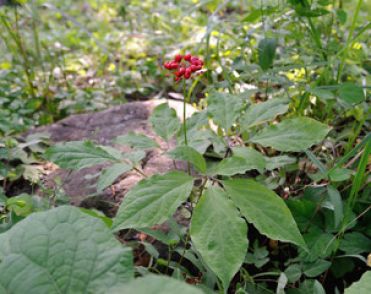How to Find Wild Ginseng

Wild ginseng refers to unprocessed ginseng plant or its components. Wild American ginseng has been declared an endangered fauna species by the authorities in the USA. It can only be harvested in certain US states. Wild ginseng plants grow in natural forest covers and are of very good quality due to their natural growing environment.
Harvesting Wild Ginseng
It is not easy to harvest wild ginseng. You need to know how to properly identify the herb that is fully mature to harvest. It takes five to six years for ginseng to mature. You also need to know the proper way to harvest the roots without damaging them. Most of all, you also need to know the right places to harvest wild ginseng.
Ginseng grows in deciduous forest covers with maple, beech, oak, and hickory trees. Ginseng also requires a shaded area to grow. So, you need to find shaded places within these forests to find ginseng.
Ginseng plant leaves consist of 3-7 leaflets. Flowers will appear as the plants mature, which will then produce red fruits. The berry-like fruits are an indication that a ginseng plant has matured. Several other plants can look like the ginseng plant. Poison ivy, water hemlock, and jimson weed are some poisonous plants that can look like ginseng. So, make sure you know how to properly identify the herb. Ginseng plants can be seen around other smaller plants like wild ginger, bloodroot, Indian turnip, and ferns.
It is essential to harvest only a few plants and then leave at least a few to help it reproduce further. Excessive harvesting of ginseng can endanger its population in the wild. It is also essential to extract the roots using proper tools so as to not destroy it. It is also crucial to protect the nearby immature ginseng roots while harvesting the matured ones.
Harvesting of wild ginseng is a very delicate and difficult process. It also requires you to obtain necessary paperwork and permits to harvest the ginseng. Every country and territory has its own regulations regarding harvesting wild ginseng. So, make sure you know the protocols and laws regarding harvesting wild ginseng.
You also need to wear the right gear to protect yourself from insects and snakes while in the forest looking for wild ginseng.
It is a good practice to plant back the seeds from the berries adjacent (or quite near) to the harvest root. You can simply dig up the ground a few inches and plant the seeds. It is good a practice that can help wild ginseng to grow without becoming an endangered herb.
The harvesting season for each region can differ by a few weeks here and there. So, it is important to be aware of all the information you need to find wild ginseng for harvesting it yourself.
Finding Wild Ginseng
One easy way to find wild ginseng is to purchase it through online shops. Reputed ginseng farms often sell their produce through their own ecommerce stores or other online retailers. For example, if you want to find good quality wild American ginseng; look for the herb from the online shops of Wisconsin-based ginseng farms. Wisconsin ginseng is one of the most potent varieties of American ginseng. Many ginseng farms also harvest wild ginseng ethically and make it available for consumers after cleaning and drying the root properly.
You can find wild ginseng in powder or root forms in the online retail stores. You can also find different root sizes and quantities. The quality of the wild ginseng can also differ from low grade to high. So, you have a wide variety of options to choose from depending on your requirements.
Many companies also sell aged wild ginseng. Ginseng can grow in the wild for many years if not harvested upon maturation. Matured ginseng plants can have even more potent properties depending on the soil and the forest shaded area. The active compounds in ginseng can become more powerful as the roots age in the wild.
Wild American ginseng is not easily available. Only experts who know how to find and harvest wild ginseng without damaging the roots can provide you the best product.
